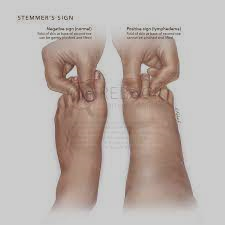The importance of self-screening for lymphedema in cancer patients is under-recognized and there are not many tools available to use. Below you will find a few ways to monitor yourself for early signs of lymphedema. This is essential because if lymphedema is caught early enough (stages 0 & 1), you may be able to prevent it from worsening.
#1 Visual comparison
The first visual sign of lymphedema is unexplained swelling in the limb or area that has undergone cancer treatment. This swelling will quite often build up over the day or with physical activity but diminishes or goes away on elevation or overnight (while laying down).
When: Perform this visual comparison in the evening.
How: If the swelling is in the arm or leg then compare one side to the other. Visually note if one looks larger than the other. If you are looking at the lower limb or trunk region, stand in front of a mirror and look at both front and back views.
Visual cues: Note the circumference of the limbs (arm/legs), look at bony protrusions and compare each side, look for veins and tendons and compare each side. For example, you may notice some veins on the back of the hand on one side and not the other. This may indicate fluid retention in the hand.
If initially you don’t see any differences or swelling then continue to monitor every couple of weeks for the first year. If you do notice some differences or swelling then check with your doctor or seek out a therapist who specializes in Manual Lymph Drainage. Remember, the sooner you seek treatment the better!
#2 Stemmer’s Sign

This test is typically best used by a practitioner to determine the stage of lymphedema. However, it can also be used as a self-screening tool to indicate if there is edema in the hand or foot.
When: Perform this test in the evening.
How: Pinch and lift the skin on the top of the middle finger close to the knuckle (if arm edema) or the second toe close to the base of the toe (if leg edema). Perform this on both hands or feet and compare.
Visual cues: If you can lift the skin equally and with the same pliability on both hands/feet, then you are not showing signs of lymphedema, however, you may still show symptoms of lymphedema elsewhere. Conversely, if the flesh on your suspected hand/foot feels more solid and you have difficulty (or can’t) lift the skin, then you may be showing signs of lymphedema.
This test looks for the presence of swelling and fibrotic tissue (thickened tissue) in the hands or feet. Swelling arising from other causes such as venous insufficiency does not typically include fibrosis and should not produce a positive test result. If you do suspect you are testing positive then check with your doctor or seek out a therapist who specializes in Manual Lymph Drainage. Remember, the sooner you seek treatment the better!
#3 Patient’s perception
Feelings of heaviness or fullness in the arm/leg can be among the very first symptoms of lymphedema. Some studies suggest that some individuals are able to perceive these sensation changes before any measurable volume differences appear. Be mindful that this is very individualized as not everyone can perceive these sensations or changes. But it still can be useful information and therefore, important to ask or think about as a healthcare worker or patient.
When: Think about how you are feeling throughout the day but especially at the end of the day.
How: Compare one side to the other if applicable.
Cues: Are there other symptoms present on the affected side such as tiredness, numbness or tingling? Think about “how much” you feel the sensation changes (giving it a more quantitative measure). For example, my affected side feels twice as heavy as my unaffected side.
Again, although this is very individually based, it is still valuable information and useful in monitoring for lymphedema. If you are feeling these symptoms then check with your doctor or seek out a therapist who specializes in Manual Lymph Drainage. Remember, the sooner you seek treatment the better!
#4 Measurements
An increase in limb size is one of the best indicators of the presence of lymphedema. The standard approach to screening for lymphedema involves comparing the size of your suspected limb to your unaffected limb, or, comparing its size to a baseline measurement (taken pre-operatively). For self-screening purposes, we will make it relatively simple for you to do. Please note: it is useful to go have these measurements done by a healthcare professional who has a specific protocol to follow. At the end of this section, find two YouTube videos to view.
When: Measure your limb in the evening as swelling tends to be most pronounced at the end of the day. Sticking to one time of day to do the measurement is also important if you want to track your arm volume over time.
How: Measure the circumference of your limb using a flexible tape measure (like the one a seamstress uses). You need to find a starting point at the wrist or ankle (styloid process of the wrist, ankle bone of the lower leg). Be consistent with both sides (mark it with a marker or eyeliner). This is your starting point. From your starting point, measure every 15 cm up the limb, marking each point as you travel upward. These points are where you will measure your arm circumference (the distance around your arm). Be sure to not pull too tightly when measuring the circumference of the limb at your marked points. The videos below will demonstrate this however, they are doing every 4 cm. Every 4 cm is not necessary for self-screening.
Detailed measurements a Vodder Trained Therapist can perform for you:
Arm:
Leg:
